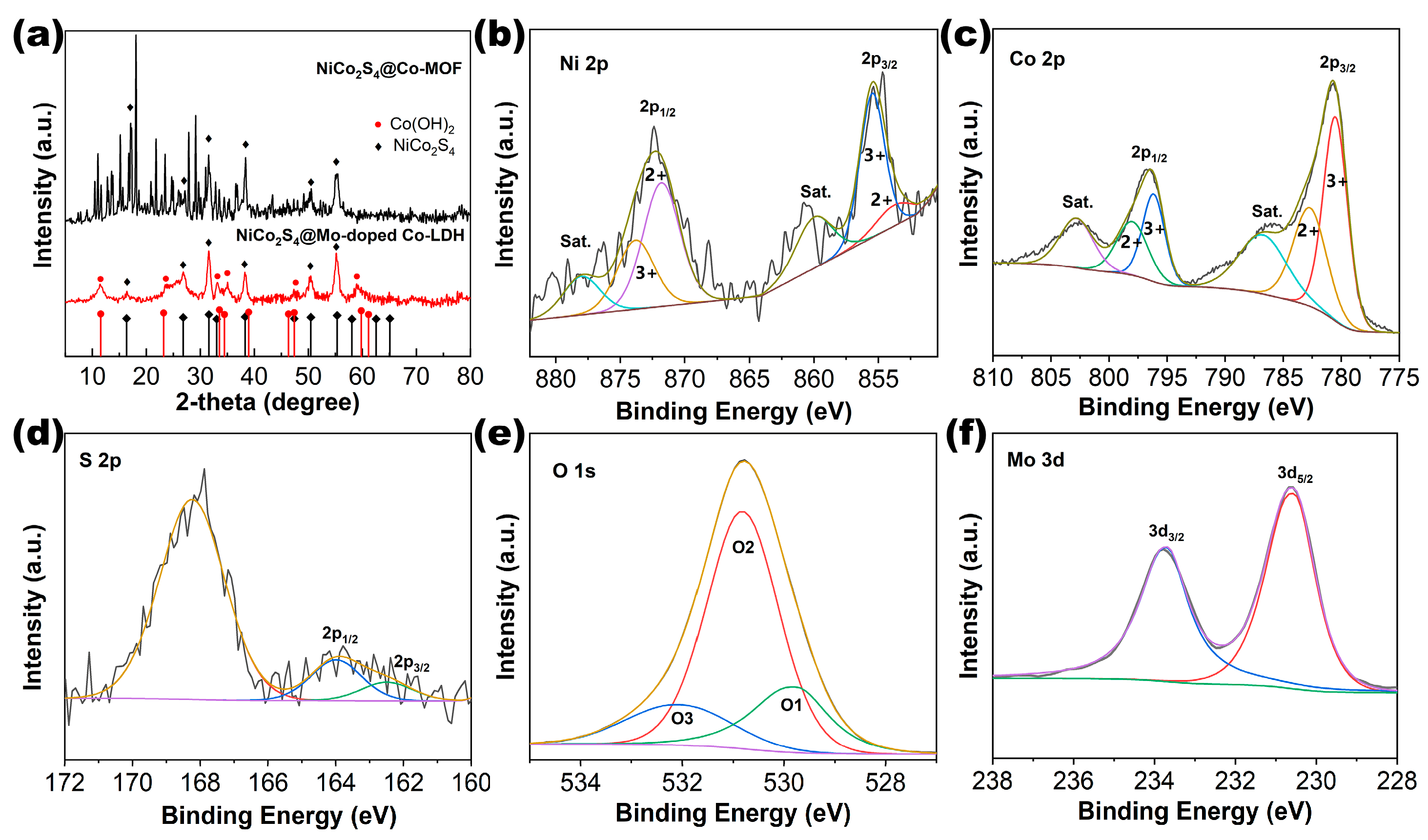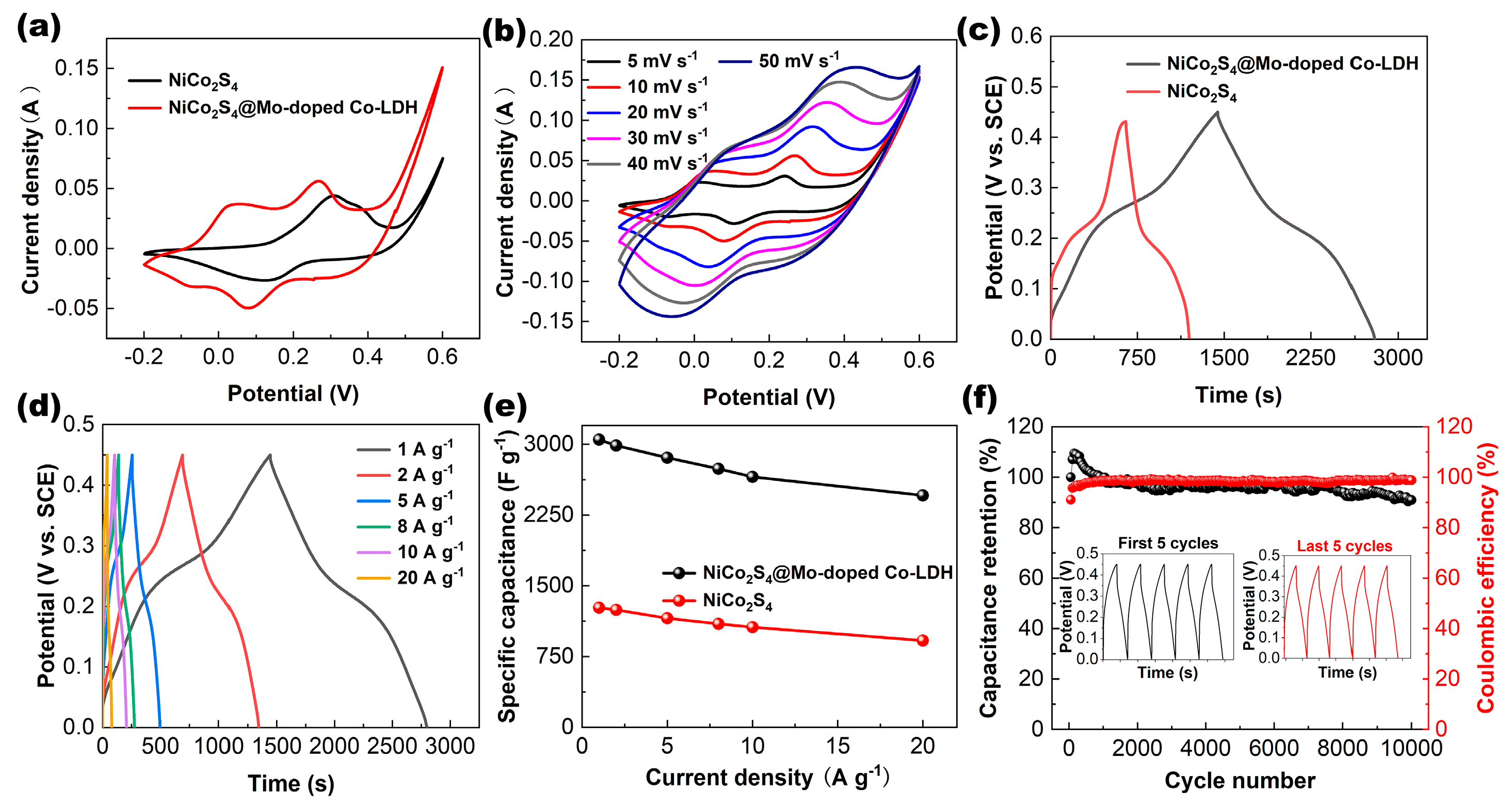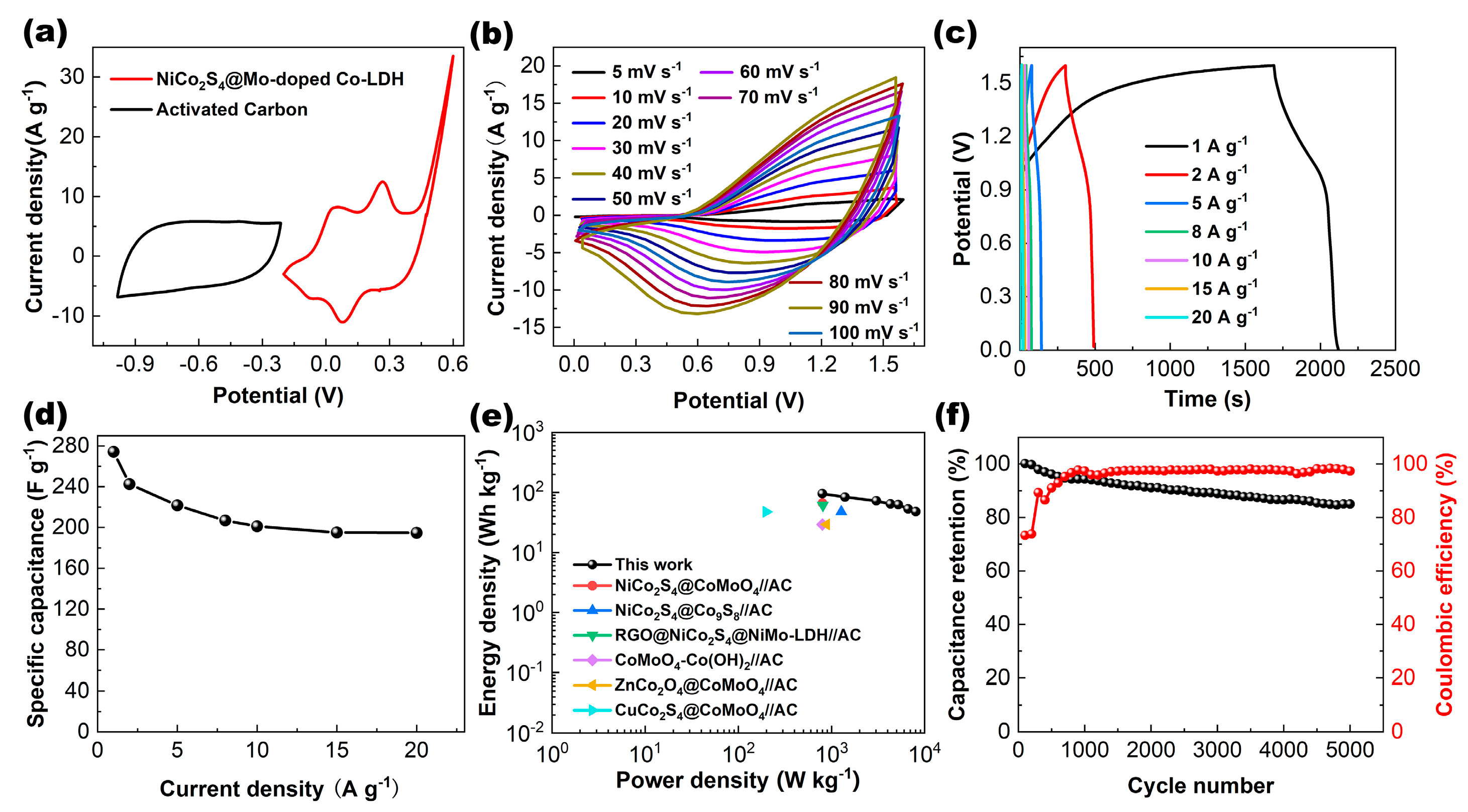Fabrication of Hierarchical MOF-Derived NiCo2S4@Mo-Doped Co-LDH Arrays for High-Energy-Density Asymmetric Supercapacitors
Abstract
:1. Introduction
2. Materials and Methods
2.1. Synthesis of NiCo2S4 Nanowires
2.2. Synthesis of NiCo2S4@Co-MOF
2.3. Synthesis of NiCo2S4@ Mo-Doped Co-LDH
2.4. Material Characterizations
2.5. Electrochemical Measurements
2.6. Preparation of All-Solid-State Asymmetric Supercapacitor (ASC)
3. Results and Discussion
3.1. Preparation and Characterizations of the NiCo2S4@Mo-Doped Co-LDH
3.2. Electrochemical Measurements of the NiCo2S4@Mo-Doped Co-LDH
3.3. Electrochemical Measurements of the NiCo2S4@Mo-Doped Co-LDH//AC Asymmetric Supercapacitor
4. Conclusions
Supplementary Materials
Author Contributions
Funding
Data Availability Statement
Acknowledgments
Conflicts of Interest
References
- Xing, F.; Bi, Z.; Su, F.; Liu, F.; Wu, Z.S. Unraveling the Design Principles of Battery-Supercapacitor Hybrid Devices: From Fundamental Mechanisms to Microstructure Engineering and Challenging Perspectives. Adv. Energy Mater. 2022, 12, 2200594. [Google Scholar] [CrossRef]
- Kumar, S.; Saeed, G.; Zhu, L.; Hui, K.N.; Kim, N.H.; Lee, J.H. 0D to 3D carbon-based networks combined with pseudocapacitive electrode material for high energy density supercapacitor: A review. Chem. Eng. J. 2021, 403, 126352. [Google Scholar] [CrossRef]
- Patil, S.A.; Rabani, I.; Hussain, S.; Seo, Y.-S.; Jung, J.; Shrestha, N.K.; Im, H.; Kim, H. A facile Design of Solution-Phase Based VS2 multifunctional electrode for green energy harvesting and storage. Nanomaterials 2022, 12, 339. [Google Scholar] [CrossRef] [PubMed]
- Sekhar, S.C.; Ramulu, B.; Arbaz, S.J.; Hussain, S.K.; Yu, J.S. One-Pot Hydrothermal-Derived NiS2–CoMo2S4 with Vertically Aligned Nanorods as a Binder-Free Electrode for Coin-Cell-Type Hybrid Supercapacitor. Small Methods 2021, 5, 2100335. [Google Scholar] [CrossRef] [PubMed]
- Kothandam, G.; Singh, G.; Guan, X.; Lee, J.M.; Ramadass, K.; Joseph, S.; Benzigar, M.; Karakoti, A.; Yi, J.; Kumar, P. Recent Advances in Carbon-Based Electrodes for Energy Storage and Conversion. Adv. Sci. 2023, 10, 2301045. [Google Scholar] [CrossRef] [PubMed]
- Zhao, J.; Wang, Y.; Qian, Y.; Jin, H.; Tang, X.; Huang, Z.; Lou, J.; Zhang, Q.; Lei, Y.; Wang, S. Hierarchical design of cross-linked NiCo2S4 nanowires bridged NiCo-hydrocarbonate polyhedrons for high-performance asymmetric supercapacitor. Adv. Funct. Mater. 2023, 33, 2210238. [Google Scholar] [CrossRef]
- Yi, T.-F.; Pan, J.-J.; Wei, T.-T.; Li, Y.; Cao, G. NiCo2S4-based nanocomposites for energy storage in supercapacitors and batteries. Nano Today 2020, 33, 100894. [Google Scholar] [CrossRef]
- Sharma, P.; Kumar, V. Current technology of supercapacitors: A review. J. Electron. Mater. 2020, 49, 3520–3532. [Google Scholar] [CrossRef]
- Brousse, T.; Bélanger, D.; Long, J.W. To be or not to be pseudocapacitive? J. Electrochem. Soc. 2015, 162, A5185. [Google Scholar] [CrossRef]
- Gogotsi, Y.; Penner, R.M. Energy storage in nanomaterials—Capacitive, pseudocapacitive, or battery-like? ACS Nano 2018, 12, 2081–2083. [Google Scholar] [CrossRef]
- Park, H.W.; Roh, K.C. Recent advances in and perspectives on pseudocapacitive materials for supercapacitors—A review. J. Power Sources 2023, 557, 232558. [Google Scholar] [CrossRef]
- Ho, K.-C.; Lin, L.-Y. A review of electrode materials based on core–shell nanostructures for electrochemical supercapacitors. J. Mater. Chem. A 2019, 7, 3516–3530. [Google Scholar] [CrossRef]
- Yang, Q.; Lu, Z.; Li, T.; Sun, X.; Liu, J. Hierarchical construction of core–shell metal oxide nanoarrays with ultrahigh areal capacitance. Nano Energy 2014, 7, 170–178. [Google Scholar] [CrossRef]
- Gonçalves, J.M.; da Silva, M.I.; Toma, H.E.; Angnes, L.; Martins, P.R.; Araki, K. Trimetallic oxides/hydroxides as hybrid supercapacitor electrode materials: A review. J. Mater. Chem. A 2020, 8, 10534–10570. [Google Scholar] [CrossRef]
- Benadji, S.; Eloy, P.; Leonard, A.; Su, B.L.; Rabia, C.; Gaigneaux, E.M. Characterization of H3+ xPMo12− xVxO40 heteropolyacids supported on HMS mesoporous molecular sieve and their catalytic performance in propene oxidation. Microporous Mesoporous Mater. 2012, 154, 153–163. [Google Scholar] [CrossRef]
- Liu, J.; Wang, J.; Zhang, B.; Ruan, Y.; Lv, L.; Ji, X.; Xu, K.; Miao, L.; Jiang, J. Hierarchical NiCo2S4@NiFe LDH heterostructures supported on nickel foam for enhanced overall-water-splitting activity. ACS Appl. Mater. Interfaces 2017, 9, 15364–15372. [Google Scholar] [CrossRef] [PubMed]
- Zhu, Y.; An, S.; Sun, X.; Lan, D.; Cui, J.; Zhang, Y.; He, W. Core-branched NiCo2S4@ CoNi-LDH heterostructure as advanced electrode with superior energy storage performance. Chem. Eng. J. 2020, 383, 123206. [Google Scholar] [CrossRef]
- Huang, J.; Xie, J.; Wang, L.; Zhang, J.; Wang, P.; Sun, P.; Yao, Z.; Yang, Y. Boosted Electrochemical Performance of Honeycomb-Like NiCu–LDH Nanosheets Anchoring on NiCo2S4 Nanotube Arrays for Flexible Solid-State Hybrid Supercapacitors. Energy Fuels 2020, 34, 13157–13166. [Google Scholar] [CrossRef]
- Singh, A.; Ojha, S.K.; Singh, M.; Ojha, A.K. Controlled synthesis of NiCo2S4@NiCo2O4 core@ Shell nanostructured arrays decorated over the rGO sheets for high-performance asymmetric supercapacitor. Electrochim. Acta 2020, 349, 136349. [Google Scholar] [CrossRef]
- Liu, J.; Yang, Z.; Yang, L.; Zhu, Y.; Xue, T.; Xu, G. Rational design of yolk-shell NiCo2O4@ void@NiCo2S4 nanospheres for effective enhancement in microwave absorption. J. Alloys Compd. 2021, 853, 157403. [Google Scholar] [CrossRef]
- Cheng, S.; Shi, T.; Huang, Y.; Tao, X.; Li, J.; Cheng, C.; Liao, G.; Tang, Z. Rational design of nickel cobalt sulfide/oxide core-shell nanocolumn arrays for high-performance flexible all-solid-state asymmetric supercapacitors. Ceram. Int. 2017, 43, 2155–2164. [Google Scholar] [CrossRef]
- Huang, Y.; Shi, T.; Jiang, S.; Cheng, S.; Tao, X.; Zhong, Y.; Liao, G.; Tang, Z. Enhanced cycling stability of NiCo2S4@NiO core-shell nanowire arrays for all-solid-state asymmetric supercapacitors. Sci. Rep. 2016, 6, 38620. [Google Scholar] [CrossRef] [PubMed]
- Liao, F.; Yang, G.; Cheng, Q.; Mao, L.; Zhao, X.; Chen, L. Rational design and facile synthesis of Ni-Co-Fe ternary LDH porous sheets for high-performance aqueous asymmetric supercapacitor. Electrochim. Acta 2022, 428, 140939. [Google Scholar] [CrossRef]
- Cheng, Y.; Wang, X.; Zhang, D.; Qiao, X.; Zhao, H.; Chang, L.; Yu, Z.; Xia, Y.; Fan, J.; Huang, C. High-capacity binderless supercapacitor electrode obtained from sulfidation large interlayer spacing of NiMn-LDH. Electrochim. Acta 2022, 429, 141039. [Google Scholar] [CrossRef]
- Zhang, R.; Dong, J.; Zhang, W.; Ma, L.; Jiang, Z.; Wang, J.; Huang, Y. Synergistically coupling of 3D FeNi-LDH arrays with Ti3C2Tx-MXene nanosheets toward superior symmetric supercapacitor. Nano Energy 2022, 91, 106633. [Google Scholar] [CrossRef]
- Wang, X.; Huang, F.; Rong, F.; He, P.; Que, R. Unique MOF-derived hierarchical MnO2 nanotubes@ NiCo-LDH/CoS2 nanocage materials as high performance supercapacitors. J. Mater. Chem. A 2019, 7, 12018–12028. [Google Scholar] [CrossRef]
- Poudel, M.B.; Lohani, P.C.; Acharya, D.; Kandel, D.R.; Kim, A.A.; Yoo, D.J. MOF derived hierarchical ZnNiCo-LDH on vapor solid phase grown CuxO nanowire array as high energy density asymmetric supercapacitors. J. Energy Storage 2023, 72, 108220. [Google Scholar] [CrossRef]
- Poudel, M.B.; Kim, A.R.; Ramakrishan, S.; Logeshwaran, N.; Ramasamy, S.K.; Kim, H.J.; Yoo, D.J. Integrating the essence of metal organic framework-derived ZnCoTe–N–C/MoS2 cathode and ZnCo-NPS-N-CNT as anode for high-energy density hybrid supercapacitors. Compos. Part B Eng. 2022, 247, 110339. [Google Scholar] [CrossRef]
- Patil, S.A.; Katkar, P.K.; Kaseem, M.; Nazir, G.; Lee, S.-W.; Patil, H.; Kim, H.; Magotra, V.K.; Thi, H.B.; Im, H. Cu@ Fe-Redox Capacitive-Based Metal–Organic Framework Film for a High-Performance Supercapacitor Electrode. Nanomaterials 2023, 13, 1587. [Google Scholar] [CrossRef]
- Rinawati, M.; Wang, Y.-X.; Chen, K.-Y.; Yeh, M.-H. Designing a spontaneously deriving NiFe-LDH from bimetallic MOF-74 as an electrocatalyst for oxygen evolution reaction in alkaline solution. Chem. Eng. J. 2021, 423, 130204. [Google Scholar] [CrossRef]
- Tang, J.; Shen, Y.; Miao, X.; Qin, H.; Song, D.; Li, Y.; Qu, Y.; Yin, Z.; Ren, J.; Wang, L. Template-directed growth of hierarchically structured MOF-derived LDH cage hybrid arrays for supercapacitor electrode. J. Electroanal. Chem. 2019, 840, 174–181. [Google Scholar] [CrossRef]
- Poudel, M.B.; Kim, A.A.; Lohani, P.C.; Yoo, D.J.; Kim, H.J. Assembling zinc cobalt hydroxide/ternary sulfides heterostructure and iron oxide nanorods on three-dimensional hollow porous carbon nanofiber as high energy density hybrid supercapacitor. J. Energy Storage 2023, 60, 106713. [Google Scholar] [CrossRef]
- Wan, H.; Jiang, J.; Yu, J.; Xu, K.; Miao, L.; Zhang, L.; Chen, H.; Ruan, Y. NiCo2S4 porous nanotubes synthesis via sacrificial templates: High-performance electrode materials of supercapacitors. CrystEngComm 2013, 15, 7649–7651. [Google Scholar] [CrossRef]
- Zhi, G.; Wang, W.; Zhou, Y.; Feng, L. ZIF-67-derived CoP/NC effectively supported Pt nanoparticles for methanol oxidation reaction. Nanoscale 2023, 15, 2948–2953. [Google Scholar] [CrossRef] [PubMed]
- Chen, T.-Y.; Kuo, T.-R.; Yougbaré, S.; Lin, L.-Y.; Xiao, C.-Y. Novel direct growth of ZIF-67 derived Co3O4 and N-doped carbon composites on carbon cloth as supercapacitor electrodes. J. Colloid Interface Sci. 2022, 608, 493–503. [Google Scholar] [CrossRef] [PubMed]
- Sun, Y.Y.; Zhang, X.Y.; Tang, J.; Li, X.; Fu, H.Q.; Xu, H.G.; Mao, F.; Liu, P.; Yang, H.G. Amorphous Oxysulfide Reconstructed from Spinel NiCo2S4 for Efficient Water Oxidation. Small 2023, 19, 2207965. [Google Scholar] [CrossRef] [PubMed]
- Shen, X.; Li, H.; Zhang, Y.; Ma, T.; Li, Q.; Jiao, Q.; Zhao, Y.; Li, H.; Feng, C. Construction dual-regulated NiCo2S4@ Mo-doped CoFe-LDH for oxygen evolution reaction at large current density. Appl. Catal. B Environ. 2022, 319, 121917. [Google Scholar] [CrossRef]
- Ranganatha, S.; Munichandraiah, N. Sol–gel synthesis of mesoporous α-Co(OH)2 and its electrochemical performance evaluation. ACS Omega 2018, 3, 7955–7961. [Google Scholar] [CrossRef]
- Cui, H.; Ma, W.; Wang, L.; Xue, J. Preparation of α-Co(OH)2 monolayer nanosheets by an intercalation agent-free exfoliation process. J. Sol-Gel Sci. Technol. 2016, 78, 293–298. [Google Scholar] [CrossRef]
- Guan, C.; Xiao, W.; Wu, H.; Liu, X.; Zang, W.; Zhang, H.; Ding, J.; Feng, Y.P.; Pennycook, S.J.; Wang, J. Hollow Mo-doped CoP nanoarrays for efficient overall water splitting. Nano Energy 2018, 48, 73–80. [Google Scholar] [CrossRef]
- Xiao, Y.; Chen, X.; Li, T.; Mao, Y.; Liu, C.; Chen, Y.; Wang, W. Mo-doped cobalt hydroxide nanosheets coupled with cobalt phosphide nanoarrays as bifunctional catalyst for efficient and high-stability overall water splitting. Int. J. Hydrogen Energy 2022, 47, 9915–9924. [Google Scholar] [CrossRef]
- Lin, J.; Zhong, Z.; Wang, H.; Zheng, X.; Wang, Y.; Qi, J.; Cao, J.; Fei, W.; Huang, Y.; Feng, J. Rational constructing free-standing Se doped nickel-cobalt sulfides nanotubes as battery-type electrode for high-performance supercapattery. J. Power Sources 2018, 407, 6–13. [Google Scholar] [CrossRef]
- Lv, Y.; Duan, S.; Zhu, Y.; Yin, P.; Wang, R. Enhanced OER performances of Au@NiCo2S4 core-shell heterostructure. Nanomaterials 2020, 10, 611. [Google Scholar] [CrossRef] [PubMed]
- Li, X.; Yin, S.; Cai, L.; Wang, Z.; Zeng, C.; Jiang, H.; Cheng, J.; Lu, W. Sea-urchin-like NiCo2S4 modified MXene hybrids with enhanced microwave absorption performance. Chem. Eng. J. 2023, 454, 140127. [Google Scholar] [CrossRef]
- Li, X.-X.; Wang, X.-T.; Xiao, K.; Ouyang, T.; Li, N.; Liu, Z.-Q. In situ formation of consubstantial NiCo2S4 nanorod arrays toward self-standing electrode for high activity supercapacitors and overall water splitting. J. Power Sources 2018, 402, 116–123. [Google Scholar] [CrossRef]
- Singh, B.; Indra, A. Tuning the properties of CoFe-layered double hydroxide by vanadium substitution for improved water splitting activity. Dalton Trans. 2021, 50, 2359–2363. [Google Scholar] [CrossRef] [PubMed]
- Bao, J.; Wang, Z.; Xie, J.; Xu, L.; Lei, F.; Guan, M.; Huang, Y.; Zhao, Y.; Xia, J.; Li, H. The CoMo-LDH ultrathin nanosheet as a highly active and bifunctional electrocatalyst for overall water splitting. Inorg. Chem. Front. 2018, 5, 2964–2970. [Google Scholar] [CrossRef]
- Zeng, N.; Hopkinson, D.G.; Spencer, B.F.; McAdams, S.G.; Tedstone, A.A.; Haigh, S.J.; Lewis, D.J. Direct synthesis of MoS2 or MoO3 via thermolysis of a dialkyl dithiocarbamato molybdenum (iv) complex. Chem. Commun. 2019, 55, 99–102. [Google Scholar] [CrossRef]
- Singh, B.; Patel, A.K.; Indra, A. Introduction of high valent Mo6+ in Prussian blue analog derived Co-layered double hydroxide nanosheets for improved water splitting. Mater. Today Chem. 2022, 25, 100930. [Google Scholar] [CrossRef]
- Wan, H.; Liu, J.; Ruan, Y.; Lv, L.; Peng, L.; Ji, X.; Miao, L.; Jiang, J. Hierarchical configuration of NiCo2S4 nanotube@ Ni–Mn layered double hydroxide arrays/three-dimensional graphene sponge as electrode materials for high-capacitance supercapacitors. ACS Appl. Mater. Interfaces 2015, 7, 15840–15847. [Google Scholar] [CrossRef]
- Sui, Y.; Zhang, Y.; Hou, P.; Qi, J.; Wei, F.; He, Y.; Meng, Q.; Sun, Z. Three-dimensional NiCo2S4 nanosheets as high-performance electrodes materials for supercapacitors. J. Mater. Sci. 2017, 52, 7100–7109. [Google Scholar] [CrossRef]
- Poudel, M.B.; Kim, H.J. Confinement of Zn-Mg-Al-layered double hydroxide and α-Fe2O3 nanorods on hollow porous carbon nanofibers: A free-standing electrode for solid-state symmetric supercapacitors. Chem. Eng. J. 2022, 429, 132345. [Google Scholar] [CrossRef]
- Zhao, Y.; Dong, H.; He, X.; Yu, J.; Chen, R.; Liu, Q.; Liu, J.; Zhang, H.; Yu, J.; Wang, J. Carbon Cloth Modified with Metal-Organic Framework Derived CC@ CoMoO4-Co(OH)2 Nanosheets Array as a Flexible Energy-Storage Material. ChemElectroChem 2019, 6, 3355–3366. [Google Scholar] [CrossRef]
- Zhao, Y.; He, X.; Chen, R.; Liu, Q.; Liu, J.; Song, D.; Zhang, H.; Dong, H.; Li, R.; Zhang, M. Hierarchical NiCo2S4@CoMoO4 core-shell heterostructures nanowire arrays as advanced electrodes for flexible all-solid-state asymmetric supercapacitors. Appl. Surf. Sci. 2018, 453, 73–82. [Google Scholar] [CrossRef]
- Han, X.; Chen, Q.; Zhang, H.; Ni, Y.; Zhang, L. Template synthesis of NiCo2S4/Co9S8 hollow spheres for high-performance asymmetric supercapacitors. Chem. Eng. J. 2019, 368, 513–524. [Google Scholar] [CrossRef]
- Cheng, C.; Zou, Y.; Xu, F.; Xiang, C.; Sui, Q.; Zhang, J.; Sun, L.; Chen, Z. Ultrathin graphene@ NiCo2S4@Ni-Mo layered double hydroxide with a 3D hierarchical flowers structure as a high performance positive electrode for hybrid supercapacitor. J. Energy Storage 2022, 52, 105049. [Google Scholar] [CrossRef]
- Yu, D.; Teng, Y.; Liu, X.; Liu, X. A high-performance electrode based on the ZnCo2O4@CoMoO4 core-shell nanosheet arrays on nickel foam and their application in battery-supercapacitor hybrid device. Electrochim. Acta 2020, 347, 136278. [Google Scholar]
- Mao, X.; Wang, Y.; Xiang, C.; Zhan, D.; Zhang, H.; Yan, E.; Xu, F.; Hu, X.; Zhang, J.; Sun, L.; et al. Core-shell structured CuCo2S4@CoMoO4 nanorods for advanced electrode materials. J. Alloys Compd. 2020, 844, 156133. [Google Scholar] [CrossRef]
- Jia, H.; Wang, J.; Fu, W.; Hu, J.; Liu, Y. In-situ MOFs-derived hollow Co9S8 polyhedron welding on the top of MnCo2S4 nanoneedles for high performance hybrid supercapacitors. Chem. Eng. J. 2020, 391, 123541. [Google Scholar] [CrossRef]
- Sui, Y.; Zhang, Y.; Hu, H.; Xu, Q.; Yang, F.; Li, Z. High energy density asymmetric supercapacitor based ZnS/NiCo2S4/Co9S8 nanotube composites materials. Adv. Mater. Interfaces 2018, 5, 1800018. [Google Scholar] [CrossRef]
- Zhang, Y.; Xu, J.; Zheng, Y.; Zhang, Y.; Hu, X.; Xu, T. NiCo2S4@NiMoO4 core-shell heterostructure nanotube arrays grown on Ni foam as a binder-free electrode displayed high electrochemical performance with high capacity. Nanoscale Res. Lett. 2017, 12, 412. [Google Scholar] [CrossRef]
- Guo, Y.; Hao, C.; Wang, X.; Yang, Y.; Wang, X.; Wu, J.; Shen, Y. Facile fabrication of CoNi-Layered Double Hydroxide/NiCo2S4/Reduced Graphene Oxide composites by in situ hydrothermal growth strategy for supercapacitor performance. Ceram. Int. 2022, 48, 17644–17653. [Google Scholar] [CrossRef]
- Tang, Y.; Liu, X.; Chen, Y.; Han, L.; Dai, D.; Liu, L.; Wang, C.; Hua, Y.; Zhao, X.; Liu, X. NiCo2S4@MoS2 core/shell nanorod arrays for fabrication of high-performance asymmetric supercapacitors with high mass loading. J. Energy Storage 2022, 51, 104518. [Google Scholar] [CrossRef]




Disclaimer/Publisher’s Note: The statements, opinions and data contained in all publications are solely those of the individual author(s) and contributor(s) and not of MDPI and/or the editor(s). MDPI and/or the editor(s) disclaim responsibility for any injury to people or property resulting from any ideas, methods, instructions or products referred to in the content. |
© 2023 by the authors. Licensee MDPI, Basel, Switzerland. This article is an open access article distributed under the terms and conditions of the Creative Commons Attribution (CC BY) license (https://creativecommons.org/licenses/by/4.0/).
Share and Cite
Cheng, S.; Du, K.; Wang, X.; Han, Y.; Li, L.; Wen, G. Fabrication of Hierarchical MOF-Derived NiCo2S4@Mo-Doped Co-LDH Arrays for High-Energy-Density Asymmetric Supercapacitors. Nanomaterials 2023, 13, 2663. https://doi.org/10.3390/nano13192663
Cheng S, Du K, Wang X, Han Y, Li L, Wen G. Fabrication of Hierarchical MOF-Derived NiCo2S4@Mo-Doped Co-LDH Arrays for High-Energy-Density Asymmetric Supercapacitors. Nanomaterials. 2023; 13(19):2663. https://doi.org/10.3390/nano13192663
Chicago/Turabian StyleCheng, Siyi, Kang Du, Xiaowu Wang, Yufei Han, Longxiao Li, and Guojun Wen. 2023. "Fabrication of Hierarchical MOF-Derived NiCo2S4@Mo-Doped Co-LDH Arrays for High-Energy-Density Asymmetric Supercapacitors" Nanomaterials 13, no. 19: 2663. https://doi.org/10.3390/nano13192663



